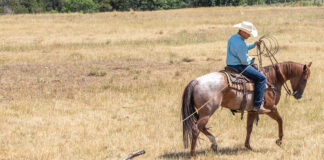Mark Bolender is a busy guy…
Mountain Trail, a relatively new competitive equestrian sport that began in 2000, was new to me. When I had the opportunity to interview Mark and get to know this warmhearted and engaging couple, Mark’s enthusiasm and passion for the sport was contagious. And after observing his clinic at Equine Affaire, I was blown away. I knew I needed to learn more.

Julie Maddock: Unlike many of your contemporaries who grew up around horses, you started riding and training later in life. What sparked your interest in horses, and how did you get started in Mountain Trail?
Mark Bolender: I got my first horse at 39. I never desired to be a trainer or a clinician. I had many other fields of interest, but my daughter asked me for a horse. So, I got her a horse and built her a barn. Then I got more horses and built a bigger facility. Later, I hired a full-time trainer to teach me to ride and travel with me to work with world-class horses as I learned traditional horse training and discovered what works.
Then I got hooked on Mountain Trail.
My wife, Lee, and I had fallen in love in Florida when we met at a clinic I was teaching. Together, we thought about making Mountain Trail an international discipline—it’s so fun and so good for the horses. Lee began the marketing, getting the Bolender name out there, and sending our info to expos—and people started to see the videos of Mountain Trail and my horse Checkers. That horse is one in a million! Checkers put me on the map, and he’s now a Breyer horse.
JM: How would you define Mountain Trail?
MB: It started for the recreational trail rider. It’s for any and every breed, for every discipline—whether it’s English, Western, stock seat, whatever—everyone can enjoy it. It’s kind of a combination of three-day eventing, dressage, and reining. We need a broke horse; we need precision. And it is fun for the horse and the rider. At Level 1, everyone is walking between the obstacles—you walk over the obstacles or through them. At Level 2, you’re trotting between the obstacles. And at Level 3, you are canter/loping between the obstacles and then stepping onto them. It sounds easy, but when you try it, it’s difficult.
JM: What would you say to a rider who is apprehensive about attending a Mountain Trail training program and the daunting course obstacles?
MB: If I can do it, you can do it. I will show you how to believe in your horse. I know where I can take you and your horse.
It’s about properly presenting the obstacle to the horse; do it right, and the balance beam should only take about five minutes to master. We are really good at demanding and telling a horse to do something, but we have forgotten the art of asking and teaching. And that is what a rider will learn in my clinics.
Instinct is very different from the intelligence of the horse. And you will never beat instinct. The instinct that the horse has to read you is far superior to your ability to read the horse. And we will show you how that works.
At our clinics, we start with riders out of the saddle. I need to get rid of the heartbeat. The horse can feel your heartbeat, your tension. So, if I can remove that from the equation, I can face the horse, and they can read my confidence. I help the horse become bold and confident and trust the rider. On average, teaching a horse to walk across a swinging bridge will take five minutes. And with 50 percent of them, I can teach them to do a 180 on it within ten minutes.
JM: How can we listen more to what our horses are saying?
MB: Learn to read their language—their eyes, muzzle, and ears twitching. You can tell what they are saying.
Put your arrogance in a box. As humans, we tend to look down on things without realizing it. With horses, we’re not superior; we’re not inferior. We’re just different. We have to step into their world and learn their language instead of bringing them to our world and values.
JM: You’ve designed and built Mountain Trail courses worldwide. How do you determine the course design?
MB: Each course is unique and built for the site. I think about how to lay it out visually, where to put the ponds, and how to make it both pretty and functional art. And horses are brutal on obstacles, so I need to engineer and build a safe course. The average course is about $200,000. We usually build all the obstacles in our shop in Washington, put them on a semi, and ship them. We arrive onsite, and building the course takes about five days. On days six and seven, we do clinics and demonstrations, and love watching people show off the horses on their new dream course.
This Q&A with Mark Bolender is a web exclusive for Horse Illustrated magazine. Click here to subscribe!





